
Long gone are the times when users of Linux We did not have tools in quantity as it happens in Windows and to a lesser extent in Mac OS X. Today we can enjoy a present that many years ago (let's say, at the beginning of this century) we could hardly dream of, and it is the type of application that is try we even have alternatives from which we can choose. For example, we have in LinSSID an excellent tool for scan wifi networks in Linux.
It is an application developed in C ++ and Qt 5 that scans Wi-Fi networks in 2,4 Ghz and 5 Ghz channels, and allows us to find the networks that are within our reach. We can view name (SSID), MAC address, channel, security type (WPA2, WEP, WPA2 / SK) or signal strengthEverything available from an interface that, as we see in the upper image of this post, is very orderly and has many similarities with inSSIDer (a tool for Windows).
All we have to do is install LinSSID, enter the administrator password and when the main window is displayed we select the interface from which we are going to scan (for example, wlan0) and then click on the button with the 'Play' icon . At that moment the task of wifi network scan, which takes a few seconds.
We can download LinSSID (both 32-bit and 64-bit versions) from your space on Sourceforge or if we use Ubuntu, install it by downloading the .deb package found there.
WPA shows them to me as WEP.
I did not know it, I am going to prove it.
It's a disaster, the application keeps moving until its controls are off the screen.